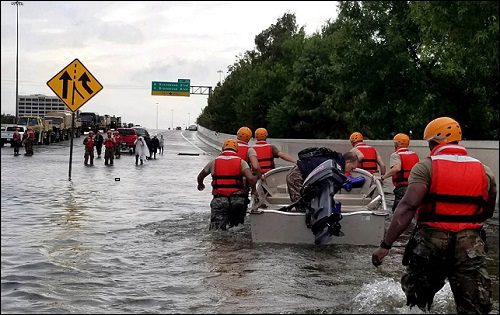Hurricane Harvey’s devastation in Texas and other areas brought transportation systems to a standstill for days, and promised to leave a growing toll as infrastructure damages can be counted when flood waters recede.
The killer storm also left a growing toll on the people in its path, with at least 47 reported dead by the morning of Sept. 1, tens of thousands housed in shelters – especially in Houston – and an undetermined number of homes and businesses destroyed or damaged.
It also left one of the nation’s largest commercial centers shut down for days, and likely hampered for months as it and other area cities try to recover.
The immense impact soon triggered calls for Congress to respond by drawing up a special disaster aid package that would replenish the shrinking funds available for the Federal Emergency Management Agency to help Texas and other storm-socked areas, and to rebuild infrastructure.
After striking the Texas Gulf Coast with Category 4-level winds that quickly knocked down street lights and signs, Harvey then stalled over the Houston area and dumped a record amount of rainfall that left miles of roads and railroad tracks flooded.
Even after Harvey moved on to Louisiana and then northward toward Tennessee and Kentucky, it was not clear how long Houston’s roads would stay flooded as swollen rivers and bayous continued to spill outside their banks.
Emergency operations focused on rescuing people trapped by the quick-spreading flood zones.
Texas Department of Transportation crews quickly began repairing downed street lights, signage and roads in areas they could reach, and assessing damage. The USDOT helped by sending $25 million from the Federal Highway Administration’s emergency relief account on Aug. 29, at a point when Gov. Greg Abbott said more than 530 roads were flooded or closed. (See related story.)
“As TxDOT faces the enormous challenge to respond and address Harvey’s path of destruction, agency leaders say the federal funds will help them with everything from debris removal and traffic light replacement to bridge and road repairs,” Abbott’s announcement said.
However, it was clear that much of the damage assessments would have to wait for floods to ebb, and for crews to see how much area roads and bridges were stripped of pavement or undermined.
The normally busy Houston Ship Channel and ports of Galveston and Houston were closed for days, as were Houston airports. Major railroads BNSF and Union Pacific halted terminal operations and reported track washouts in an area with major hubs for cross-country trains and those moving in and out of Mexico.
Days after the storm first struck, BNSF told customers Aug. 29 that “given the size and scope of this historic flooding, normal train flows in the area are not likely to resume for an extended period.” However, two days later it reported that crews were “making significant progress in restoring rail service and facility operations in the Houston area and other areas of southeastern Texas.”
As with roads and bridges, railroad track damage from floods can vary, since fast flood currents can both strip away surface infrastructure and scour out supporting material.
The storm disrupted both cruise and cargo ship traffic in the Gulf, and barge traffic serving fuel and chemical plants along the Intracoastal Waterway.
The nation’s largest petroleum fuels pipeline system also shut down in stages as it ran out of product, saying it would return to operation when Texas and Louisiana refineries could again supply it.
And with those refinery and pipeline closures, motor fuel began rising across the country. The AAA motor club reported a national average gasoline price of $2.519 a gallon by Sept. 1, up about 17 cents from a week earlier when the storm had yet to reach Texas.

